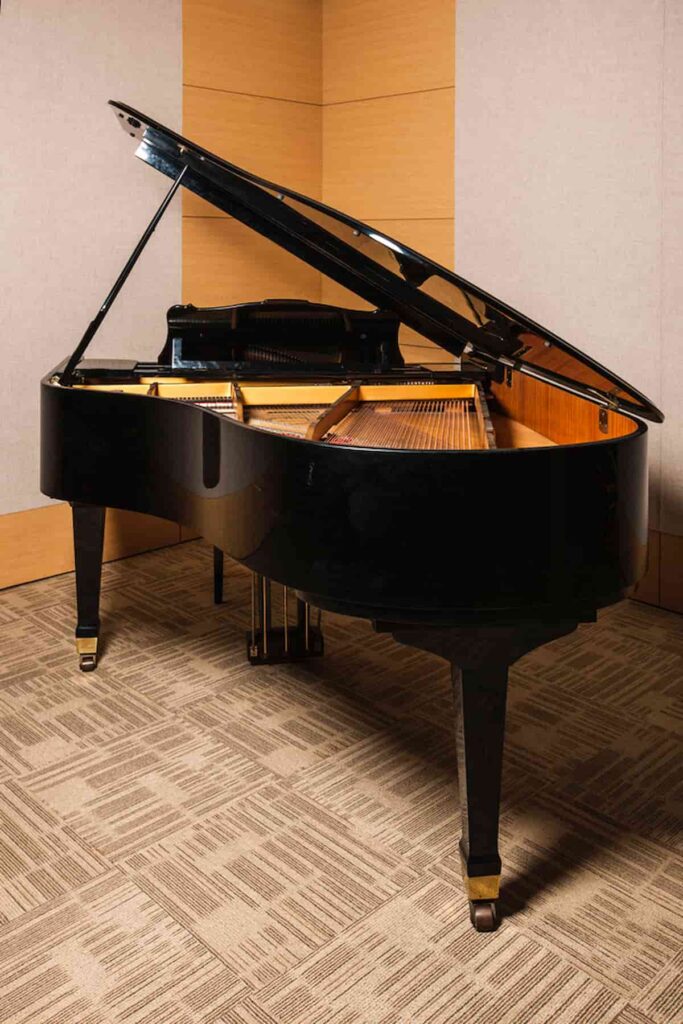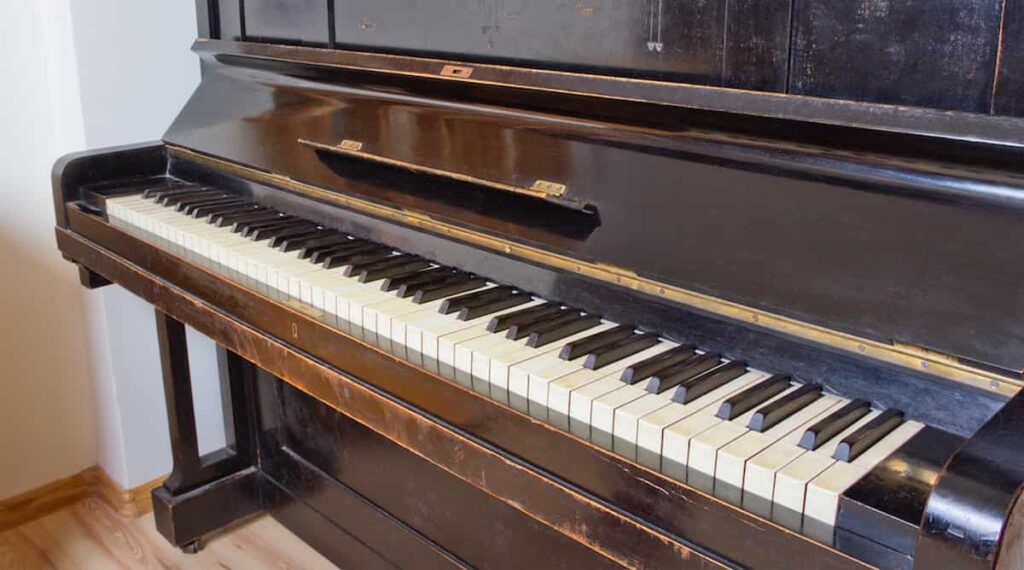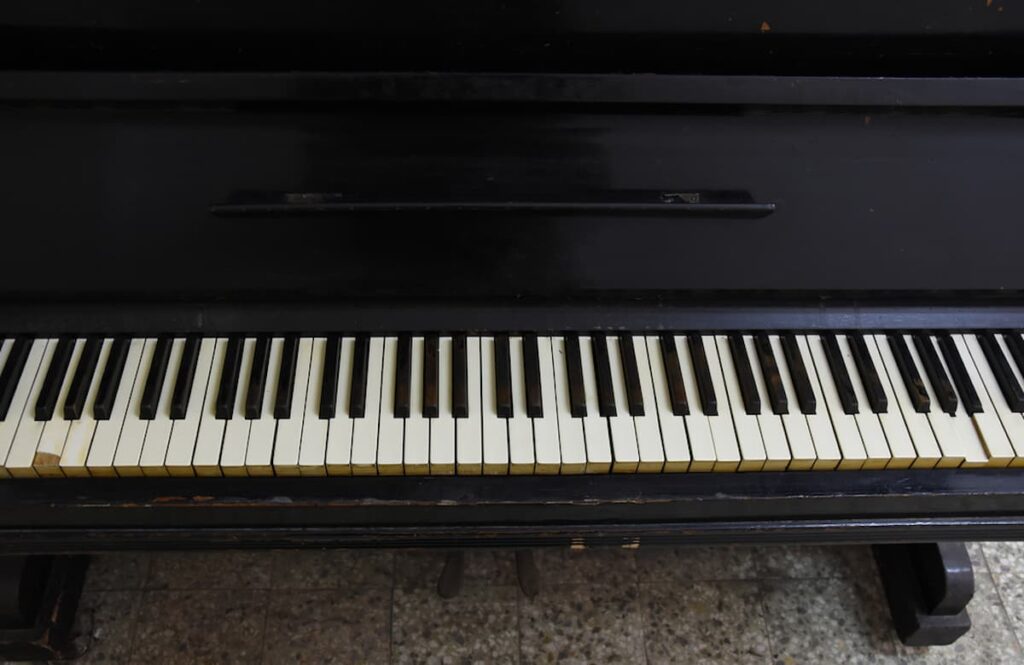As an Amazon Associate I earn from qualifying purchases.
Having done many outdoor concerts in my time as a pianist, I’ve wondered if it’s safe to flip a piano on its side during a move.
It turns out that yes, you can flip a piano on its side with relatively no issues. Moving a piano on its back or side does not necessarily harm the instrument as long as it’s done properly and with care.
Read on as I’ll share my findings on when and how it’s best to flip a piano on its side, as well as some helpful tips for those facing the challenge of moving an upright or grand piano, which can be rotated or tilted without damaging the instrument.
Want to Learn Piano?Click Here

Flipping a Piano On Its Side – The Process
Before flipping a piano on its side, there are several things to keep in mind.
Firstly, it’s crucial to hire professional piano movers who have the proper experience and equipment. While moving a piano on its side may be safe, it can still be a challenging task for those who are not familiar with the process. Professionals should also have insurance, so if any issues occur during the move, you’ll be covered.
Next, it’s essential to protect the piano’s most vulnerable parts: the legs. When lifting the piano, avoid grabbing it by the legs as this can lead to damages. Make sure the movers pick it up from the main body of the instrument and lift with their legs to prevent any unnecessary strain or injury.
Additionally, it’s important to remember that while flipping a piano on its side can be safe, laying it completely flat is not recommended. This positioning may cause damage to the inner mechanics of the instrument. So, it’s best to keep the piano upright during the moving process.
Moving a piano can be a daunting task, but knowing the right way of handling it can make all the difference. By flipping the piano on its side, ensuring the proper protection and support, and choosing experienced professionals for the job, you’ll help ensure a safe and successful relocation of your precious instrument.
Preparation and Safety Measures
As a piano enthusiast, I’ve learned that moving a piano can be quite the challenge. However, I have discovered that with proper preparation and safety measures, it’s possible to flip a piano on its side safely. Here are some tips I’ve gathered to help you:

Piano Disassembly
First things first – disassembling some parts of the piano can make it easier to move. If your piano has legs, I recommend removing them carefully to avoid any damage. For grand pianos, you can also unscrew and remove the top, which will make it easier to tilt the piano on its side.
Protecting the Piano
When moving a piano, it’s essential to protect its delicate parts. I’ve found that wrapping the pedals in a blanket or towel and securing them with tape can save them from potential harm.
In addition, it’s crucial to cover all painted and lacquered surfaces with moving blankets or padded fabric, secured with masking or electrical tape. This will shield the piano from dents and scratches during the moving process.
Gathering Proper Equipment
To ensure a safe and efficient move, I’ve learned that having the right equipment at hand is invaluable. If your piano is on wheels, make sure that the brakes are engaged or employ a piano dolly to help with transportation.
Moreover, using heavy-duty lifting straps can aid in tilting and moving the piano to its destination. And don’t forget, having friends or professional piano movers to assist you can make all the difference in completing this task safely and successfully.
By following these preparation and safety measures, I believe that you can successfully move a piano on its side without causing damage or harm to the valuable instrument.
Procedure for Flipping a Piano
When I began our process of flipping a piano on its side, I realized that it’s important to know the correct method to do it safely. We don’t want to risk damaging the piano or causing any potential injuries.

Grand Piano Process
The first step in flipping a grand piano was to ensure proper padding is placed around the piano to avoid scratching or denting the surface. I used a thick, soft blanket for this purpose. Next, I made sure to close and secure the lid to prevent it from opening during the flip.
Together with a few helping hands, we gently lifted one side of the piano to allow a piano board to slide underneath the piano’s flat side. Once the board was in place, we carefully lowered the piano so it rested on the board. We then used ratchet straps to secure the piano to the board, making sure there was enough tension for stability.
Upright Piano Process
For an upright piano, I followed a similar initial approach of padding and securing the piano to prevent any scratches, dents, or damage. Next, I gathered some reliable helpers, as upright pianos are heavy and require multiple people to lift and maneuver safely.
We tilted the piano on its side, and one person placed a sturdy, flat dolly underneath the piano’s flat top. This ensured a solid ground and allowed us to move the piano with ease. We then used ratchet straps to secure the piano to the dolly, ensuring proper tension and stability.
Following these processes, I could safely flip grand and upright pianos on their sides. It’s important to remember that while anyone can do these processes, it’s always the safest option to consult or hire professional piano movers to handle this task.
Risks and Potential Damage To Your Piano
When I moved my piano on its side, there were a few risks and potential damages that I had to consider. This section will discuss the most common concerns, including tuning and calibration issues, and physical damage to the piano and flooring.

Tuning and Calibration Issues
One of the first concerns I had was whether flipping the piano on its side would affect its tuning and calibration. Since a piano’s sound quality is heavily dependent on the accurate tension of its strings and the precise alignment of its action mechanism, I was worried that moving it incorrectly could cause adverse effects.
Thankfully, in my experience, pianos can be moved, tilted, and rotated without causing significant harm to their musical qualities.
However, it’s essential to handle the instrument carefully during the moving process so as not to disrupt its sensitive components. Furthermore, once the piano has been placed in its new location, it’s a good idea to have a professional tuner check and adjust it as necessary.
Physical Damage to Piano and Flooring
In addition to the potential impact on the piano’s sound quality, I also had to be cautious about possible physical damage to the instrument and my home’s flooring. Pianos can weigh anywhere from 300 to 900 pounds, which means that improper handling could easily scratch, dent, or even break sensitive flooring and tile.
To protect both the piano and my floors, I followed several precautions during the move:
- Utilizing a padded piano dolly, which evenly distributed the weight and allowed for smooth transport
- Securing the piano with heavy-duty straps to prevent it from slipping or shifting on the dolly
- Enlisting the help of friends or professional movers to ensure enough manpower for safely lifting, turning, and navigating with the piano
- Using protective coverings or padding on both the piano and any surfaces it might come into contact with, such as doorways and walls
By taking these precautions and handling the piano with care, I was able to minimize the risks and potential damages associated with moving it on its side.
Professional Help and Costs
In this section, I’d like to discuss the process of hiring a professional piano mover and the costs and benefits associated with it.
Hiring a Professional Piano Mover
Professional piano movers possess the knowledge, expertise, and equipment to move pianos safely and efficiently. They understand the instrument’s structure, the best way to disassemble and reassemble it if needed, and how to secure it during the move.
When I decided to hire a piano mover, I made sure to get quotes from multiple companies to compare their services and pricing. It’s essential to verify their credentials and read reviews from previous customers to ensure they have a good reputation in handling pianos.
Costs and Benefits
The cost of hiring a professional piano mover can be quite varied, depending on the type of piano, distance, and complexity of the move. In my experince, it can be as low as $100 and go up to $500 or more. Distance, climbing steps, and more all factor into those costs.
Yes, its expensive, however, I believe that the benefits outweigh the costs.
- Safety: Professional movers have the skills and equipment to move the piano without causing any injuries to themselves or others involved.
- Damage protection: By using proper padding and securing the piano correctly, professionals minimize the chance of damaging the instrument or its surroundings.
- Efficiency: When I hired a professional mover, they were able to transport my piano more quickly and safely than if I had attempted it myself.
- Peace of mind: Knowing that my piano was in the hands of a skilled professional gave me relief, allowing me to focus on other moving tasks.
A Few Things To Consider
Ultimately, flipping a piano on its side has its place when it comes to moving the instrument from one location to another. Ideally though, you’ll want to avoid moving yoru piano aroudn too much, espeically if you’re not using a professional mover in the process.
The piano has a ton of parts and bumping it can cause things to shift, throw out the tuning, and ultimatley cause some serious damage. So, the next time you try this, be smart, get help, and be gentle with your instrument, especially if its a grand piano!
Hello & thanks for stopping by! I’m a professional concert pianist and piano instructor. In the United States, I’ve given successful performances in several places including New York, Florida, Connecticut, & New Jersey, I have also performed internationally in Italy and made my Carnegie Hall debut in 2014. I enjoy blogging about the piano, the art of performance, general music, current events and the latest in music production.
